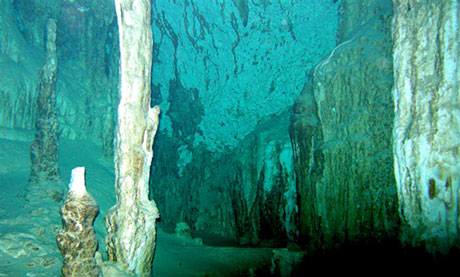

by Tab Hauser
One of the most amazing dives I have ever done was in the Mayan Riviera near Tulum called Dos Ojos. Dos Ojos (two eyes in Spanish) is a cenote or cavern dive that, to me, comes as close to a cave dive as one can get without the training and the redundancy systems required for that type of technical diving.

Dos Ojos gets its name from two caverns close together but connected by a common area. This natural set up makes for two perfect 45 to 50 minute shallow dives. I said this is as close to cave diving as one can get because there are there are "swim through tunnels" and "rooms" along the trail that are completely closed to any surface air and are completely dark. Most of the other cenotes I dove in Mexico are much more open in which you will swim under ledges and around the rock formations but you still see plenty of light nearby.

The underwater cave system to which Dos Ojos is connected runs about 200 km, making it of the top 5 longest cave systems in the world. While we bottomed out at 29 feet, Dos Ojos has one of the deepest sections in the area going down almost 120 meters or 400 feet.

To dive this cenote you are required to pay a small fee and have a dive master guide you. As safety is paramount here the dive master is allowed no more than 4 divers with him and he must wear two tanks at all times.

The dives here are shallow and the depths of several to twenty feet change frequently. That means that your ears should be able to adjust easily. You also must have good buoyancy control and remember to weight yourself appropriate for fresh water. This is because you will be swimming over and around boulders and stalagmites while watching not to bump your head on stalactites on ceiling above. I would not recommend this dive for a beginner but to someone who is comfortable with their skills and not afraid of dark or confined areas. This dive is a swim through a series of small and medium size caverns and what seems like short "tunnels" no more than 15 feet (about 5meters) in diameter. Much of the dive you can see some light in the distance. There are several places you that are totally dark except for the light from your group from their flashlights. On my first visit here Jose requested we all turn our flashlights off in one area for a moment just to show us we could not see our hands in front of our masks.

Both times I dove this sight I was in awe of not only of the rock formations but also from the different rooms we were swimming in and through. I can also understand why IMAX and the BBC Planet Earth used this place for their documentaries. While traveling about I always like to visit caves. I have walked in caves in New Zealand, New York, the Mohave Desert, swam though them in Belize. Doing it underwater gives you a 3 dimensional sense of the place. Another words rather than look up from the walkway of a cavern floor to see the features on its ceiling, here you can float up for a fishes eye view. During our dive there were many areas that we were able to follow where the stalactites came from the ceiling. We were also able to follow down to where the stalagmites started on the floor in some cases 10 feet below. In some smaller caverns we swam around pillars where the two had met. During your Dos Ojos dive you will eventually surface at the Bat Cave. This large cavern had a tall ceiling where we saw bats flying about or resting. It is also a place where a small ladder leads to a hole in the ceiling of the cavern allowing a diver to leave if there is a problem or to allow snorkellers to climb down and check out this section. At the end of the second dive Carlos took us to a corner of one of the submerged rooms where a sign is planted in front of a narrow opening showing a skeleton warning of dangers going past if you are not cave certified.

The start and finish of both dives ends up in an area that resembles a pool with a rock outcropping over most of this area. It is here where the snorkellers get to cool off and get a peek at what the place looks like. The fresh water temperature of the cave remains 75F and is very clear. Divers are requested to do a frog kick rather than a flutter kick to keep the sediment on the bottom. Visibility while seemingly unlimited is really only as good as the light available or the distance of the flashlight. While the place can make beautiful photography, it can make for difficult shots unless you have some of the best strobe equipment. The flip side to this type of photography was to keep the flash off and dial my ISO settings a little high to get a more natural look. While the Maya Riviera may be connected to the largest coral reef system in North America, I recommend divers come inland to try the cenotes or caverns for which this area is also famous.
The cenotes (and reefs) of the Mayan Riviera can be reached by flying into Cancun airport on the Yucatan peninsula. Tulum is just under a 90 minute drive from the airport.
By Tab Hauser
tabhauser.com/
For more photos of diving Dos Ojos see tabhauser.com/DosOjosCavern.htm
Please send us your comments on Mexico. Do you want to recommend a diving centre or dive site? Let us know. Have a question - we're waiting to hear from you.